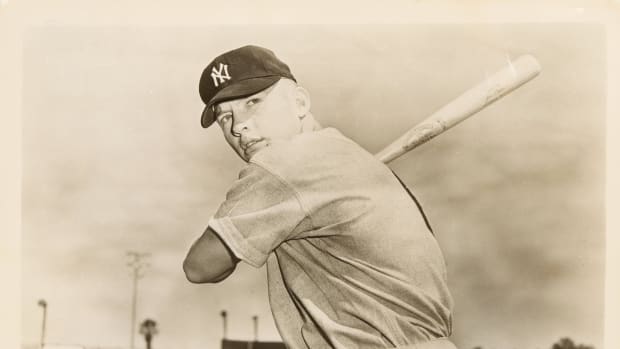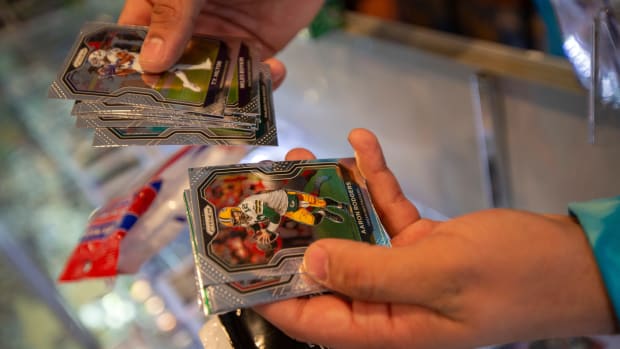
Making the Card: 2024 Topps Series 1 Baseball
Sports Illustrated aims to feature only the best products and services. If you buy something via one of our links, we may earn a commission.
For many collectors, there is no single sports card release more important and influential than 1952 Topps Baseball.
Featuring a fresh design, larger cards, vibrant colors and an impressive lineup of star players to chase, Topps’ original flagship baseball release changed card collecting forever.
Now, over 70 years later, Topps Series 1 Baseball remains arguably the most important product in the sports card hobby — and that’s why Topps spends a year planning and designing a product it hopes will excite collectors, while signaling the start of baseball season.
“It’s the most comprehensive product that exists and it’s the first product that we release in a season every year,” said Clay Luraschi, VP of Product Development for Topps. “We have to make sure that it’s speaking to the fan, speaking to the collector.”
Set to release on Feb. 14 behind cover athlete Ronald Acuna Jr., 2024 Topps Series 1 Baseball features one of its more unique designs in recent years. Highlighted by a neon glow around the border and the team name, the 2024 set won’t be mistaken for any other.
According to Robert Grabe, a senior designer for Topps and the architect behind this year’s design, the neon glow has become the star, but that wasn’t always the plan.
“Because this comes up every year, I’m kind of brainstorming all year long — I’ve already got some ideas on paper for 2025,” Grabe said. “I didn’t start out thinking I should make a neon card, but I like seeing cards with color and when you’re opening the base set and you’re going through a lot of cards, you want some variety in there.
“Then it’s like, well, last year we did this with a color border and the year before that, so what haven’t we done recently? I added the glow and that looks like neon, so it gave me a direction to build toward and it just evolved that way.”
The process doesn’t get much easier from there. While the neon outline might be eye-catching, it also complicated the design. The outline around the team names, Grabe says, became a problem.
“You wouldn’t think the name at the top would be so hard,” Grabe says. “You think you’d just type out a name but it turned out to be pretty difficult. You can’t just squish or squeeze it because then you’ll have uneven letters. So I ended up hand-lettering all 30 teams plus the leagues and a few former teams because you never know when you’ll need an Expos card.”
Beyond the neon glow, collectors immediately noticed the black border at the top. For many, that dark border would end any hopes of regular PSA 10s on the base set.
For Grabe, it was a much-needed design audible inspired by an older set.
“The smoke at the top was a late add because I was worried that not all of the team names would be legible,” Grabe said. “The Rays have a yellow name up there and it was against a white border, so that’s where knowing your history comes in handy.”
In 2024, nearly all card designs take some inspiration from previous sets. For this release, the much-needed addition came from the 1980s.
“One of my favorite sets is the 1986 set and it’s got this big black bar at the top with a brightly-colored team name,” Grabe said. “Well, what if I try something like that and update it? I feel like 1986 gave me permission to try something like that here.”
As for the grading aspect, Luraschi says collectors shouldn’t be worried.
“I know the 1986 set, no pun intended, gets dinged a little bit, but the way we’re printing now is so much different,” Luraschi said. “We had a long discussion about how that could potentially impact condition, but we feel confident that with the way we’re cutting cards today, you’re going to have a much better experience than you did in 1986.”
Another design aspect that collectors quickly noticed was a “First Card” designation on one of the earliest preview images. Appearing on a card for Cincinnati Reds star Elly De La Cruz, something seemed off — that wasn’t his first card.
“There’s 350 cards in the base set and every single one will have a 1/1 First Card variation,” Luraschi said. “Basically, it’s the first card that’s printed. There’s no correlation between a First Card and a rookie card. The only cards with that logo are the first ones off the printer.”
According to Luraschi, the First Card designation is an additional chase for a product with over a dozen different SKUs. It’s also an Easter egg for a set that is meant to reflect on 2023 while previewing 2024.
For months, Topps Series 1 operates almost like a living set with the product development team making constant changes to its configuration and contents. If a major event changes the storyline of the season, Series 1 might need to change too.
After securing feedback on what worked and didn’t work from the 2023 release, the team can focus on finer details. Thoughtful inserts and image variations are among the many moving parts that make Series 1 difficult to manage from beginning to end.
This release of Series 1, for example, features short-printed cards for Shohei Ohtani with the Los Angeles Dodgers and Juan Soto with the New York Yankees. Both Ohtani’s signing and Soto’s trade didn’t happen until December.
“I’m personally trying to squeeze things in there up to the last second because I want it to be as current as possible,” Luraschi said. “But at some point you have to draw the line. So that’s a challenge I always have. Our job is to make the best product for the collector, for the consumer, for the fan, and we’ll go to any length to make that happen. So it’s a happy challenge.”
While Luraschi is focusing on making the product a great value for collectors, Grabe and the design team have to make sure Series 1 makes sense for a variety of products. The design for Series 1 appears in multiple products, including the signature Topps Chrome set.
From a design and expectations standpoint, Luraschi believes that Series 1 sets the expectations for the rest of the company’s baseball products.
“It’s extremely important and that’s why everyone on the team puts blood, sweat and tears into this thing,” he said. “It’s the reason we looked at 12 different designs — and trust me, the second place design and third place design are outstanding and they’ll probably get used next year or maybe repurposed in some other products.”
Setting the tone for just Topps’ products might be an understatement, though.
For many new collectors, Series 1 might be their first experience with trading cards. There’s the expectation that there’s a legacy to uphold, too. If that original 1952 set changed collecting, new Series 1 sets need to continue building on that foundation.
Luraschi and the rest of the team know that.
“Years ago, it was the only product that Topps focused on because it was the only product,” Luraschi said. “Now, we do lots of different products but the approach to it hasn’t changed. It has a legacy and everyone knows the importance of that and what it means to not only them, but the company and what it means to everyone else.
“We are all very, very passionate about what we do and I want nothing more than thousands and thousands of people every year to come into this and want to get into this hobby. And we’re going to do everything we can to make that happen.”
Sports Illustrated aims to feature only the best products and services. If you buy something via one of our links, we may earn a commission.








